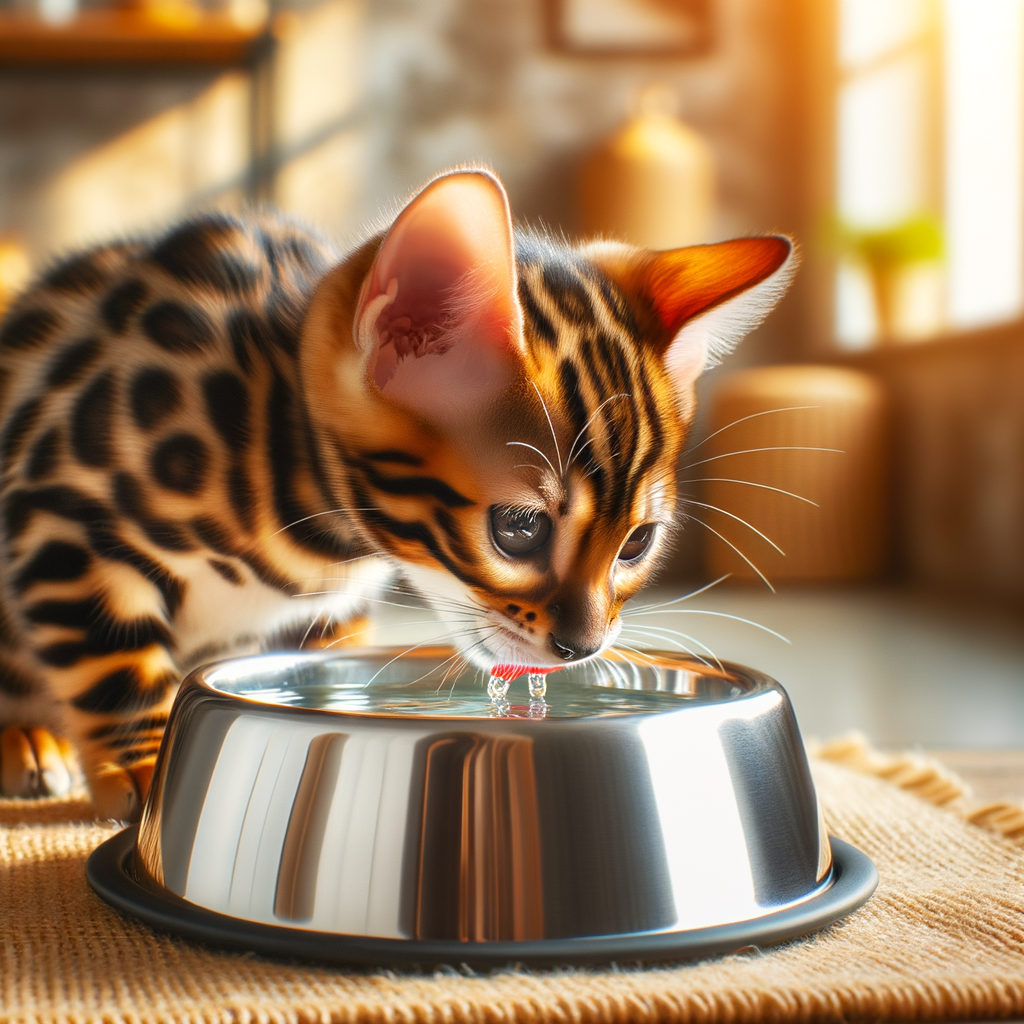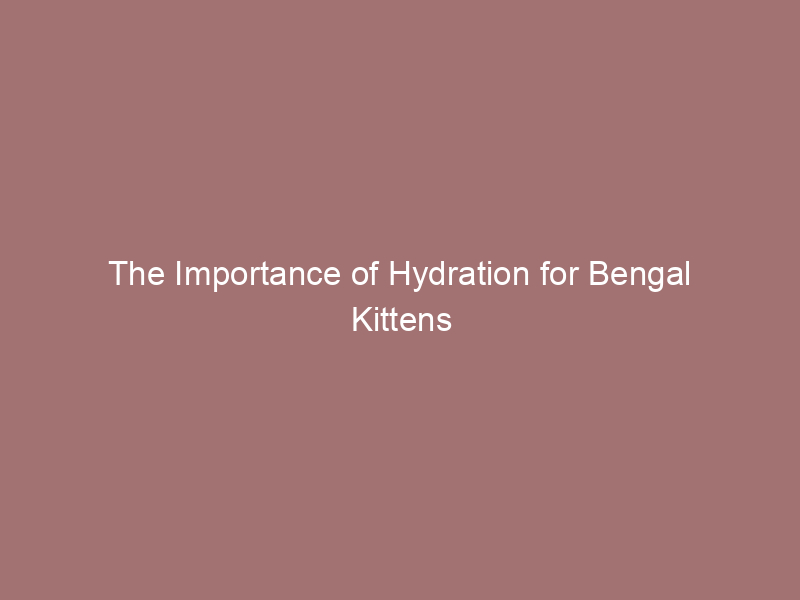
The Importance of Hydration for Bengal Kittens
-
Understanding the Role of Hydration in a Bengal Kitten’s Health
Water helps with digestion, nutrient absorption, and maintaining a healthy body temperature. Without enough water, kittens can become dehydrated, which can lead to serious health problems.
Dehydration can cause:
- Dry mouth and nose
- Sunken eyes
- Lethargy
- Loss of appetite
Ensuring your Bengal kitten drinks enough water helps them stay active and healthy.
-
Why Bengal Kittens Have Unique Hydration Needs
Bengal kittens are known for their high energy and playful nature. This means they may need more water than other breeds. Their active lifestyle causes them to lose water faster, making it essential to keep them well-hydrated.
Additionally, Bengal kittens have a unique coat that can affect their hydration. Their fur is dense and can trap heat, leading to increased water loss through panting.
Here is a table summarizing their unique hydration needs:
Factor Impact on Hydration High Energy Levels Increased water loss Dense Fur Traps heat, leading to more panting Playful Nature Higher water requirements By understanding these needs, you can ensure your Bengal kitten stays hydrated and healthy.
Bengal Kitten Hydration Tips
Best Hydration Practices for Bengal Kittens
-
How often to provide water:
Bengal kittens need fresh water available at all times. Make sure to refill their water bowl at least twice a day. This helps keep the water clean and encourages your kitten to drink more.
-
Types of water bowls to use:
Use shallow, wide bowls made of stainless steel or ceramic. These materials are easy to clean and do not harbor bacteria. Avoid plastic bowls as they can cause skin irritation and may develop scratches that trap germs.
-
Integrating hydration into feeding routines:
You can mix a small amount of water into your kitten’s wet food. This not only makes the food more palatable but also ensures they get extra hydration. Additionally, consider feeding them wet food, which has a higher moisture content than dry kibble.
| Hydration Tip | Details |
|---|---|
| Provide Fresh Water | Refill water bowls twice daily to keep water clean and appealing. |
| Choose the Right Bowl | Use stainless steel or ceramic bowls to avoid bacteria buildup. |
| Mix Water with Food | Add water to wet food to increase hydration. |
Bengal Kitten Drinking Habits
- Observing your kitten’s drinking patterns:Watch how much your Bengal kitten drinks each day. A healthy kitten should drink water regularly. You can use a small bowl or a water fountain to see how much water is being consumed. If your kitten drinks too little, it might get dehydrated.
According to Wikipedia, cats generally need about 3.5 to 4.5 ounces of water per 5 pounds of body weight each day. Keep an eye on your kitten’s drinking habits to ensure they are within this range.
- How to encourage regular drinking:There are several ways to make sure your Bengal kitten drinks enough water:
- Fresh Water: Always provide fresh water. Change it at least once a day.
- Multiple Bowls: Place water bowls in different areas of your home.
- Wet Food: Include wet food in their diet. Wet food has more water content than dry food.
- Water Fountains: Some kittens prefer running water. A water fountain can make drinking more fun.
By following these tips, you can help your Bengal kitten stay hydrated and healthy.
Hydration Needs for Bengal Kittens
Water Requirements for Bengal Kittens
-
How much water a Bengal kitten needs daily:
A Bengal kitten typically needs about 2-4 ounces of water per 5 pounds of body weight each day. This amount can vary based on their diet and activity level.
-
Factors that affect water intake:
- Diet: Kittens eating wet food may drink less water because wet food contains a lot of moisture.
- Activity Level: More active kittens may need more water to stay hydrated.
- Environment: Hotter climates can increase a kitten’s need for water.
- Health: Illnesses or medical conditions can affect how much water a kitten needs.
| Factor | Impact on Water Intake |
|---|---|
| Diet | Wet food reduces the need for additional water. |
| Activity Level | Higher activity increases water needs. |
| Environment | Hot climates increase water needs. |
| Health | Medical conditions can increase or decrease water needs. |
Ensuring Hydration for Bengal Kittens
-
Checking for Signs of Dehydration
Check if your Bengal kitten is dehydrated. Here are some signs to look for:
- Dry gums: Gently touch your kitten’s gums. They should be moist. If they are dry, your kitten might be dehydrated.
- Skin elasticity: Gently pinch the skin on the back of your kitten’s neck. If it doesn’t snap back quickly, this could be a sign of dehydration.
- Sunken eyes: Look at your kitten’s eyes. If they appear sunken, this is another sign of dehydration.
-
What to Do If Your Kitten Is Not Drinking Enough Water
If your Bengal kitten is not drinking enough water, here are some steps you can take:
- Provide fresh water: Make sure your kitten always has access to fresh, clean water. Change the water at least once a day.
- Use a water fountain: Some kittens prefer running water. A water fountain can encourage them to drink more.
- Add water to food: You can mix a little water into your kitten’s wet food to increase their water intake.
- Offer wet food: Wet food has a higher water content than dry food. This can help keep your kitten hydrated.
- Consult a vet: If your kitten continues to avoid drinking water, it’s best to consult a veterinarian for advice.
Bengal Kitten Health and Hydration
Preventing Dehydration in Bengal Kittens
-
Importance of regular vet check-ups:
Vets can spot early signs of dehydration and other health issues. They can also provide advice tailored to your kitten’s specific needs. According to Wikipedia, veterinarians play a key role in ensuring the well-being of pets.
-
How to prevent dehydration during hot weather:
Make sure they have access to fresh water at all times. You can also use a pet water fountain to encourage them to drink more. Keep your home cool and avoid letting your kitten stay outside for long periods during peak heat. Providing wet food can also help increase their water intake.
Signs of Dehydration in Bengal Kittens
- Physical signs to look out for:Dehydration in Bengal kittens can show up in several ways. One clear sign is dry gums. If you gently press on their gums, they should turn white and quickly return to pink. If this doesn’t happen, your kitten might be dehydrated.
Another sign is skin elasticity. You can check this by gently pinching the skin at the back of their neck. If the skin doesn’t snap back quickly, it could mean they are dehydrated.
Additionally, sunken eyes and a dry nose are other physical signs that your Bengal kitten might need more fluids.
- Behavioral changes that may indicate dehydration:One common change is lethargy. If your usually playful kitten seems tired and less active, it could be a sign of dehydration.
Another behavioral change to watch for is a decrease in appetite. Dehydrated kittens might not feel like eating as much as they usually do.
Lastly, if your kitten is drinking less water or avoiding their water bowl, this could be a red flag. Always make sure they have access to fresh water.






